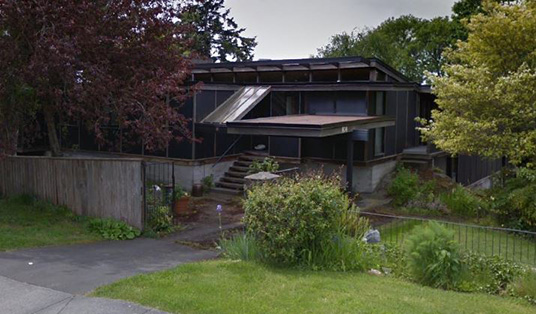Heritage Register
Victoria West
404 Henry Street
Built
1962; 1976
Heritage-Designated 2020
For: Alan & Sheila Hodgson
Architect: Alan James Hodgson

ARCHITECTURE:
The single‐storey 2,360 sq. ft. house is a West Coast Modern style frame house occupying two 55’x110’ city lots at the SW corner of Henry and Mary Streets in Vic West, City of Victoria. The site consists of a rocky outcropping which dominates the adjacent neighbourhood. An ‘L’ shaped plan hugs the northwest corner of the two lots, the house itself oriented around a mid‐lot garden. Plans on file with the City indicate an additive construction process starting in 1962 and finishing in 1989. Designed in elevation and plan on an 8’x4’ grid module to make efficient use of plywood sheeting, this material was used both for the exterior envelope and interior finishes. A series of flat roofs angle off a central low‐rise shed roof which shelters a west‐facing clerestory. The house was designed by architect Alan James Hodgson (1928‐ 2018) for his own family.
.
404 Henry Street has cultural and historical value for its association with architect Alan Hodgson and the Victoria Modernist Movement. Alan Hodgson was one of a group of young architect‐ pioneers who established practices in Victoria after WWII and were at the forefront of British Columbia’s Modernist Movement. The expanding economy and social optimism of the period encouraged experimentation and innovation in architectural design. Hodgson was born in Victoria and trained at the new UBC School of Architecture. He articled in the Public Works Department of the Provincial Government and was an early exponent of the emerging West Coast Modern style. However, like one of his contemporary professional colleagues, Peter Cotton, he also had parallel practice in architectural restoration, culminating in his appointment as consulting restoration architect for the Parliament Buildings beginning in 1972.
The Hodgson House has aesthetic value both as a representative West Coast Modern design that demonstrated respect for nature and indigenous materials, and a highly personal design plan. The house is made up of multiple volumes that cantilever around a sloping rock formation in the middle of the site. The majority of windows face inwards, creating a series of landscape views of the dramatic topography and native vegetation. The relatively blank street‐facing elevations of the house provide a screen from the adjacent streets while opening into the interior rock‐scape naturalized garden.
An 8’x4’ design module, expressed in the treated plywood exterior, was innovative and according to his wife driven by the need for economy. The modules also facilitated the flexibility of the layout and matched 2’x4’ frame construction technology, allowing for numerous additions and alterations as the family grew and finances allowed. In this case, with the process under Hodgson’s firm control, his design intent at the outset is respected and built on throughout these improvements.
Although a contrast to the late Victorian and Edwardian texture of the bungalows in the adjacent neighbourhood, the Hodgson House is actually part of a cluster including two nearby Hodgson commissions: 604/606 Mary Street (1977) for his mother, and 531/533 Mary Street (1977) and 307 Henry Street (1972).
The Hodgson House design fits within a series of domestic commissions that the architect undertook, ranging from the 1961 MacDonald House (1961 Crescent Road, Victoria 1961‐1962) to the Dr. James Warren House (2989 Baynes Road, Saanich, 1969‐1970), which was designated by the Municipality of Saanich and received the National Heritage Conservation Award in 1981, and the 1969 Elza Mayhew House and Studio (330 St. Lawrence Street), designated by the City of Victoria.
CHARACTER DEFINING ELEMENTS:
- Low‐scale form and massing of the building, designed as a series of connected architectural volumes arranged along the edges of the site, which displays influences from Scandinavian and American West Coast sources
- Composition of the building
- Structural design, which enables the building to cantilever over the rock formation
-
West Coast Modern elements including:
--- Geometric/orthogonal plan
---
Glazed curtain walls
---
Strip clerestory windows
---
Exterior brise soleil
---
Carport
---
Exposed wood finishes
- Economical and innovative exterior design expressed through the use of painted 4’ x 8’ plywood exterior cladding with cedar trim boards at the seams
-
Predominance of native landscaping throughout the property, which is an early expression of conservation ethics
- Fenestration pattern, with a majority of windows oriented towards the interior of the site.
* from Statement of Significance by Martin Segger
ADDITIONAL INFORMATION & IMAGES:
• Vic West History
• Vic West Heritage Register
• This Old House, Victoria's Heritage Neighbourhoods,
Volume One: Fernwood & Victoria West

